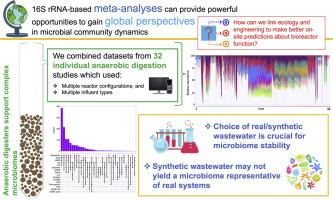高速率厌氧消化器的微生物群揭示了“研究”-合成废水的特定因素和局限性
IF 12.4
1区 环境科学与生态学
Q1 ENGINEERING, ENVIRONMENTAL
引用次数: 0
摘要
厌氧消化(AD)是有机废物处理和可再生能源生产的关键技术。这一过程的稳定性取决于潜在的微生物种群。扩增子测序越来越多地用于表征AD微生物组,但测序工作尚未转化为微生物组的工艺工程或使用微生物工具预测失败。利用高速率生物膜废水生物反应器作为研究系统,我们旨在i)识别古细菌和细菌多样性的趋势,ii)鉴定核心AD微生物组,iii)确定AD微生物组的功能稳定性,以及iv)将分类群与实验条件相关联。我们分析了32个高速率厌氧消化器研究的扩增子测序数据(>;1258个样本)在不同的操作条件下,并应用了一套统计微生物组工具。我们发现古细菌的分类多样性高度依赖于研究,而功能多样性在研究中高度共享。核心AD微生物组鉴定为>;100个细菌属和6个古细菌属在>;至少50%的样品中相对丰度为1%。有趣的是,我们观察到微生物组的稳定性受到真实废水或合成废水的选择的显著影响,合成废水产生的微生物组更稳定,更不复杂。这与合成废水中37个分类群的丰度相关,其中包括3个关键产甲烷菌(Methanothrix、Methanobacterium和Methanosphaerula)。这表明,当合成废水用于实验研究时,它可能不会产生代表真实废水处理系统的AD微生物组。本文章由计算机程序翻译,如有差异,请以英文原文为准。

Microbiomes of High-Rate Anaerobic Digestors Reveal ‘Study’-Specific Factors and Limitations of Synthetic Wastewater
Anaerobic digestion (AD) is a key technology for the treatment of organic wastes and the production of renewable energy. The stability of the process hinges on the underlying microbial populations. Amplicon sequencing is increasingly used to characterise AD microbiomes, yet sequencing efforts have not translated to process engineering of the microbiome or prediction of failure using microbial tools. Using high-rate biofilm wastewater bioreactors as a study system, we aimed to i) discern trends in archaeal and bacterial diversity, ii) identify a core AD microbiome, iii) determine the functional stability of AD microbiomes, and iv) correlate taxa to experimental conditions. We analysed amplicon sequencing data from 32 high-rate anaerobic digestor studies (> 1,258 samples) at various operational conditions and applied a suite of statistical microbiome tools. We found that taxonomic archaeal diversity was highly study dependent, while functional diversity was highly shared across studies. A core AD microbiome was identified with > 100 bacterial genera and 6 archaeal genera which were present at > 1 % relative abundance in at least 50% of samples. Interestingly, we observed that microbiome stability was significantly impacted by the choice of real or synthetic wastewater, with synthetic wastewaters yielding a more stable and less complex microbiome. This was correlated to the abundances of 37 taxa in the synthetic wastewater, including 3 key methanogens (Methanothrix, Methanobacterium, and Methanosphaerula). This suggests that when synthetic wastewater is used in experimental studies, it may not result in an AD microbiome representative of real wastewater treatment systems.
求助全文
通过发布文献求助,成功后即可免费获取论文全文。
去求助
来源期刊

Water Research
环境科学-工程:环境
CiteScore
20.80
自引率
9.40%
发文量
1307
审稿时长
38 days
期刊介绍:
Water Research, along with its open access companion journal Water Research X, serves as a platform for publishing original research papers covering various aspects of the science and technology related to the anthropogenic water cycle, water quality, and its management worldwide. The audience targeted by the journal comprises biologists, chemical engineers, chemists, civil engineers, environmental engineers, limnologists, and microbiologists. The scope of the journal include:
•Treatment processes for water and wastewaters (municipal, agricultural, industrial, and on-site treatment), including resource recovery and residuals management;
•Urban hydrology including sewer systems, stormwater management, and green infrastructure;
•Drinking water treatment and distribution;
•Potable and non-potable water reuse;
•Sanitation, public health, and risk assessment;
•Anaerobic digestion, solid and hazardous waste management, including source characterization and the effects and control of leachates and gaseous emissions;
•Contaminants (chemical, microbial, anthropogenic particles such as nanoparticles or microplastics) and related water quality sensing, monitoring, fate, and assessment;
•Anthropogenic impacts on inland, tidal, coastal and urban waters, focusing on surface and ground waters, and point and non-point sources of pollution;
•Environmental restoration, linked to surface water, groundwater and groundwater remediation;
•Analysis of the interfaces between sediments and water, and between water and atmosphere, focusing specifically on anthropogenic impacts;
•Mathematical modelling, systems analysis, machine learning, and beneficial use of big data related to the anthropogenic water cycle;
•Socio-economic, policy, and regulations studies.
 求助内容:
求助内容: 应助结果提醒方式:
应助结果提醒方式:


